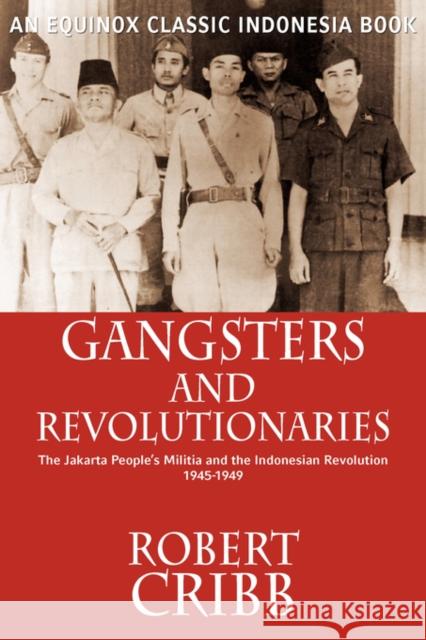Gangsters and Revolutionaries: The Jakarta People's Militia and the Indonesian Revolution 1945-1949 » książka
Gangsters and Revolutionaries: The Jakarta People's Militia and the Indonesian Revolution 1945-1949
ISBN-13: 9789793780719 / Angielski / Miękka / 2008 / 248 str.
Gangsters and Revolutionaries: The Jakarta People's Militia and the Indonesian Revolution 1945-1949
ISBN-13: 9789793780719 / Angielski / Miękka / 2008 / 248 str.
(netto: 181,27 VAT: 5%)
Najniższa cena z 30 dni: 177,57 zł
ok. 16-18 dni roboczych.
Darmowa dostawa!
Gangsters and Revolutionaries is the first in-depth study of one of the people s armies which emerged from the chaos at the close of World War II in Indonesia to join the struggle for Indonesian independence in 1945. It traces the story of the People s Militia of Greater Jakarta from its origins as a loose network of petty criminals and labor bosses in the slums of urban Jakarta and the feudal estates of the surrounding countryside, to its destruction at the hands of the Indonesian army in the late 1940s.
This book examines the social basis of the Indonesian revolution, especially the ways in which the revolutionary forces made use of existing social structures in mobilizing a popular following. It also highlights the painful process by which the new Indonesian state discarded and suppressed groups which had been instrumental in its own rise to power.
Archival records, contemporary newspapers and interviews with survivors have been used to shed new light on the early history of the Indonesian army, showing a tangled politics in which regular and irregular units, general staff officers and the Ministry of Defense vied for influence and struggled to formulate a strategy for guerrilla war.
Gangsters and Revolutionaries introduces a host of unexpected but fascinating characters, from the cat-eating General Mustopo and the implacable Haji Darip to the gangster unit which saw service with the Dutch as Her Majesty s Irregular Troops.
Robert Cribb is Senior Fellow in Indonesian History at the Australian National University. His research focuses on Indonesian national identity, mass violence, environmental politics and historical geography. He is the author of the Historical Atlas of Indonesia (2000)."
Gangsters and Revolutionaries is the first in-depth study of one of the ‘people’s armies’ which emerged from the chaos at the close of World War II in Indonesia to join the struggle for Indonesian independence in 1945. It traces the story of the People’s Militia of Greater Jakarta from its origins as a loose network of petty criminals and labor bosses in the slums of urban Jakarta and the feudal estates of the surrounding countryside, to its destruction at the hands of the Indonesian army in the late 1940s.This book examines the social basis of the Indonesian revolution, especially the ways in which the revolutionary forces made use of existing social structures in mobilizing a popular following. It also highlights the painful process by which the new Indonesian state discarded and suppressed groups which had been instrumental in its own rise to power.Archival records, contemporary newspapers and interviews with survivors have been used to shed new light on the early history of the Indonesian army, showing a tangled politics in which regular and irregular units, general staff officers and the Ministry of Defense vied for influence and struggled to formulate a strategy for guerrilla war.Gangsters and Revolutionaries introduces a host of unexpected but fascinating characters, from the cat-eating General Mustopo and the implacable Haji Darip to the gangster unit which saw service with the Dutch as Her Majesty’s Irregular Troops.Robert Cribb is Senior Fellow in Indonesian History at the Australian National University. His research focuses on Indonesian national identity, mass violence, environmental politics and historical geography. He is the author of the Historical Atlas of Indonesia (2000).











